
Swedish postcard by Nordisk Konst, Stockholm, no. 958/8. Harriet Bosse in Ingmarssönerna/Sons of Ingmar (Victor Sjöström, 1919). Caption: I have to do something or I won't find any rest in my soul.

Swedish postcard by Nordisk Konst, Stockholm, no. 1078/8. Richard Lund, Bror Berger and Erik Stocklassa in Herr Arnes pengar/Sir Arne's Treasure (Mauritz Stiller, 1919). Caption: On the Lookout.

Swedish postcard by Nordisk Konst, Stockholm, no. 1093/2. Photo: Svenska Biografteatren. Tora Teje in Karin Ingmarsdotter/God's Way/Karin Daughter of Ingmar (Victor Sjöström, 1920).

Swedish postcard by Förlag Nordisk Konst, Stockholm, no. 1117/6. Photo: Svensk Filmindustri. Victor Sjöström and Tore Svennberg in Körkarlen/The Phantom Carriage, (Victor Sjöström, 1920).

German postcard by Trianon-Film, 1924. Photo: Svenska-Film. Mona Mårtenson in Gösta Berlings saga/The Atonement of Gosta Berling (Mauritz Stiller, 1924).
A wave of romantic nationalist literature in Sweden
Selma Ottilia Lovisa Lagerlöf was born at Mårbacka Manor in Östra Ämtervik in Värmland, Sweden, in 1858. She was the fifth of six children of Lieutenant Erik Gustaf Lagerlöf and Elisabet Lovisa Wallroth. She was born with a hip injury caused by a lack of proper attachment of the joint ball in her hip. When Lagerlöf was three and a half years old, in the summer of 1862, she became ill and completely paralysed in both legs. This disappeared as suddenly as it had come, but during her childhood, she did not find it as easy to play as other children. Like many other children in a bourgeois environment at the time, the Lagerlöf siblings received their education at home, as the new public school system was not fully developed. Their teachers came to Mårbacka to teach, and Lagerlöf was taught both English and French.
Selma Lagerlöf was a serious and gifted child and enjoyed reading. The first novel she read was an Indian book, 'Osceola' by Thomas Mayne Reid - and at the age of seven, she decided to become a writer. When one of her benefactors, Sophie Adlersparre, encouraged her to write in prose did she do so - and became a writer. She entered the Higher Teacher Training College in Stockholm, against her father's wishes, in the autumn of 1882. During Lagerlöf's education, the family became insolvent and Mårbacka had to be sold. Her father died in 1885, the same year Lagerlöf finished her teacher training.
When Lagerlöf studied literary history, she suddenly realised that the characters and fates she had heard about during her childhood in Värmland were as imaginative as Bellman's and Runeberg's cast of characters. But it took several years and many unsuccessful attempts at writing before she made her debut as a writer. After completing her education, Selma Lagerlöf taught at the Elementary School for Girls in Landskrona from 1885 to 1895. Lagerlöf enjoyed being a teacher and was appreciated by her students. Selma Lagerlöf had the ability to tell children in a captivating way about each new country they read about, or about Jesus and his disciples.
Selma Lagerlöf was 33 years old when her debut novel 'Gösta Berlings Saga' was published in 1891 after winning a prize competition in the magazine Idun. 'Gösta Berling's tale' is one of the greatest classics of Swedish literature - a rich and fantastic tale of the Cavaliers and life in Värmland in the 19th century. Her novel broke with the stylistic ideals of the time, which advocated realistic objectivity and she started a wave of romantic nationalist literature in Sweden in the 1890s. The book received a mixed reception from critics. In 1895 Lagerlöf left her teaching post. From then on she supported herself entirely by writing, and in 1897 she moved with her aunt to Falun to be closer to her sister Gerda.
Together with Sophie Elkan, Lagerlöf made several long trips in Europe and in 1899-1900 an extended trip to the Middle East. On her return, she wrote the novel 'Jerusalem' (1901-1902), which became her great international breakthrough. Lagerlöf's most internationally known book is 'Nils Holgerssons underbara resa genom Sverige' (Nils Holgersson's Wonderful Journey) (1906-1907), which was originally commissioned and published as a textbook for elementary schools. In it, we experience the geography of Sweden through the eyes of a fourteen-year-old boy, Nils Holgersson, who flies over the country on the back of a goose.
In 1909, Selma Lagerlöf was awarded the Nobel Prize for Literature. She was awarded the prize, according to the Academy, "because of the noble ideality, the richness of imagination and the soulfulness of representation that characterise her poetry". She lived in the town of Sunne, where two hotels are named after her. She passed away in 1940 in Mårbacka, near Sunne, where a museum is located today. Although Lagerlöf is associated with Mårbacka, she lived and worked in Falun for many years, and it was there that she wrote some of her greatest works. Even after she moved back to Mårbacka, she returned to Falun several times a year.
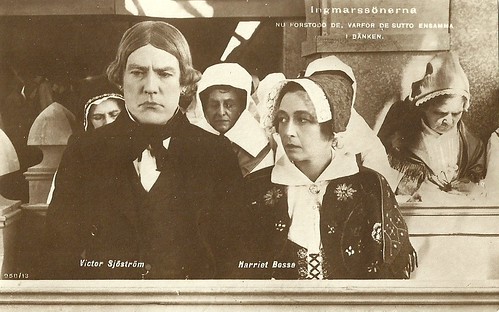
Swedish postcard by Nordisk Konst, Stockholm, no. 958/13. Harriet Bosse and Victor Sjösström in Ingmarssönerna/Sons of Ingmar (Victor Sjöström, 1919). Caption: Now they understood why they were sitting alone on the bench.

Swedish postcard by Nordisk Konst, Stockholm, no. 1078/2. Richard Lund, Bror Berger and Erik Stocklassa in Herr Arnes pengar/Sir Arne's Treasure (Mauritz Stiller, 1919). Caption: In Prison.
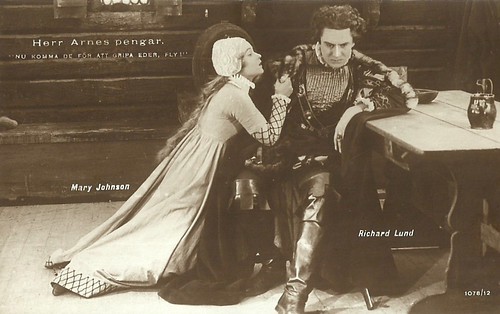
Swedish postcard by Nordisk Konst, Stockholm, no. 1078/12. Richard Lund and Mary Johnson in the Swedish silent film Herr Arnes pengar/Sir Arne's Treasure (Mauritz Stiller, 1919). Caption: They have come now to arrest you, escape!

Swedish postcard by Nordisk Konst, Stockholm, no. 1091/8. Renée Björling in Dunungen/In Quest of Happiness (Ivan Hedqvist, 1919).

Swedish postcard by Nordisk Konst, Stockholm, no. 1093/9. Photo: Svenska Biografteatren AB. Tora Teje and Bertil Malmstedt, who plays her son in Karin Ingmarsdotter/God/s Way/ Karin Daughter of Ingmar (Victor Sjöström, 1920). It is the second part in Sjöström's large-scale adaption of Selma Lagerlöf's novel 'Jerusalem', following Sons of Ingmar from the year before, and depicting chapters three and four of the novel.
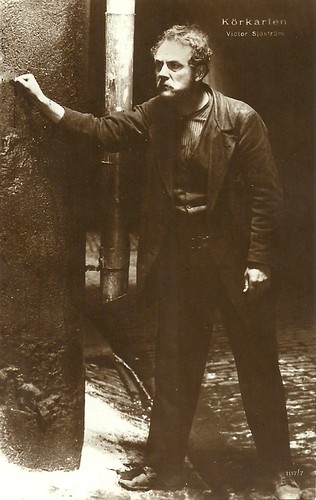
Swedish postcard by Ed. Nordisk Konst, Stockholm, no. 1117/7. Photo: vensk Filmindustri. Victor Sjöström in Körkarlen/The Phantom Carriage Victor Sjöström, 1920).
The first significant phase of Swedish cinema in film history
The first time that one of Selma Lagerlöf's books was made into a film was in 1917 with Tösen från Stormyrtorpet/The Girl from the Marsh Croft (Victor Sjöström, 1917), starring Greta Almroth, Lars Hanson and Karin Molander. The film, produced by Svenska Biografteatern AB, was the first of Sjöström's several film adaptations of Lagerlöf's literary works, heralding the first significant phase of Swedish cinema in film history. 'Tösen från Stormyrtorpet' was published in 1908 in the collection 'En saga om en saga och andra sagor'. Six other adaptions of the same novel have been made, a German and a Turkish in 1935, a Finnish in 1940, another Swedish in 1947, a Danish, Husmandstøsen (Alice O'Fredericks, 1952) and another German, Das Mädchen von Moorhof/The Girl of the Moors (Gustav Ucicky, 1958).
After the success of Tösen från Stormyrtorpet/The Girl from the Marsh Croft, Victor Sjöström adapted 'Jerusalem' (1901-1902) into a large-scale epic in two parts. Ingmarssönerna/Sons of Ingmar (1919) and Karin Ingmarsdotter/God's Way/Karin Daughter of Ingmar (1920). The latter two were both based on chapters of Lagerlöf's novel 'Jerusalem' (1901-1902), about religious emigrants from Sweden to Palestine. The two films depicted the first four chapters of the novel and featured respectively Sjöström himself as Ingmar and Tora Teje as his daughter Karin.
The critical reception for Karin Ingmarsdotter/God's Way (Victor Sjöström, 1920) was unenthusiastic. Victor Sjöström decided to not direct any more parts of Selma Lagerlöf's novel Jerusalem. Eventually, the film adaptation of the novel was finished by Gustaf Molander with Ingmarsarvet/The Ingmar Inheritance (1925) and Till österland/To the Orient (1926) with Lars Hanson, Jenny Hasselqvist and Mona Mårtenson.
Director Mauritz Stiller directed for Svenska Biografteatern the masterpiece Herr Arnes pengar/Sir Arne's Treasure (Mauritz Stiller, 1919), a crime drama based on Selma Lagerlöf’s novel The Treasure. Set on the Swedish coast in the 16th century, the film stars Richard Lund as Sir Archie, a Scottish mercenary who has escaped from a Scottish prison and fled to Sweden. The screenplay by Mauritz Stiller and Gustaf Molander differs from the novel in that it tells the story in more strictly chronological order, and incorporates some details which were introduced in the German play.
Another Swedish director, Ivan Hedqvist, made for Svenska Biografteatern the Lagerlöf adaptation Dunungen/In Quest of Happiness (Ivan Hedqvist, 1919). The film is based on a short story and play by Selma Lagerlöf, and stars Renée Björling as Dunungen. The film was Ivan Hedqvist's directorial debut and Renée Björling's film debut. Weyler Hildebrand made a remake of Dunungen in 1941 with cinematographer Julius Jaenzon who also filmed this version in 1919.
In 1920, Victor Sjöström had already filmed three novels since the contract was signed. His film adaptations had been consistently well-received by critics, audiences and Lagerlöf herself. Since the first productions had all been set in rural surroundings, Sjöström chose the urban-themed novella 'Körkarlen' (Thy Soul Shall Bear Witness!) as his new project, Körkarlen/The Phantom Carriage (1921). Filming took place at Filmstaden Studios in Solna between May and July 1920. The studio buildings were inspired by the southern Swedish town of Landskrona. Lagerlöf originally wanted to have the film shot on location in Landskrona, but Sjöström decided on a studio production due to the technical possibilities. Körkarlen/The Phantom Carriage (Victor Sjöström, 1920) premiered on 1 January 1921, New Year's Eve. It was a success at the time and is now seen as one of the classics of Swedish silent cinema.
The film had a lasting influence on the work of Ingmar Bergman, who used the character of Death in Det sjunde inseglet/The Seventh Seal (1957) and created a direct reference to the carter of Körkarlen/The Phantom Carriage (1921) by titling him "disciplinarian." In addition, Bergman enlisted Sjöström to star in Smultronstället/Wild Strawberries (1957). It was his final role. Bergman once reported that he had first watched Körkarlen at the age of 15 and every year since. In 2000, Ingmar Bergman made the TV drama Bildmakarna/The Image Makers (2000), which fictionalised the story of the making of Körkarlen/The Phantom Carriage (1920) with Anita Björk as Selma Lagerlöf and Lennart Hjulström as Victor Sjöström.
Remakes were directed by Julien Duvivier, La charrette fantôme/The Phantom Carriage (1939) starring Pierre Fresnay and Marie Bell, and by Arne Mattsson Körkarlen/The Phantom Carriage (1958) with George Fant, Ulla Jacobsson and Anita Björk. In 2012, Körkarlen/The Phantom Carriage (1921) was named the best Swedish film of all time by 50 film critics and connoisseurs in a poll conducted by the Swedish film magazine FLM.
Finnish-born director Mauritz Stiller cast Einar Hanson as the title character of Gunnar Hedes saga/The Story of Gunnar Hede (Mauritz Stiller, 1923), based on the novel 'En herrgardssaegen' by Selma Lagerlöf. Stiller had the title role first offered to Lars Hanson - not related to Einar - but Stiller found him too virile for the role, a young man who prefers to play the violin and who suffers from memory loss after being injured in a blizzard. Einar Hanson with his soft, sensitive appearance fitted better. Gunnar Hedes saga was the big breakthrough for Hanson and he went on to play leading parts in Mälarpirater/Pirates on the Malonen (Gustaf Molander, 1923), and Johan Ulfstjerna/Human Destinies (John W. Brunius, 1923).
In early 1924, Stiller had a big success with a Lagerlöf adaptation, Gösta Berling Saga/The Saga of Gösta Berling (Mauritz Stiller, 1924). Lars Hanson plays a young, attractive priest and alcoholic who has been cast out by his community and struggles to atone and regain his honour and dignity. At the end of the film, Berling gets his redemption from the hand of Elisabeth, performed by the young Greta Garbo in her first major screen appearance. Shortly after, Stiller signed a contract with the largest German film company at the time, Trianon A.G. for two films.
Finally, 'Nils Holgerssons underbara resa genom Sverige' was filmed as Nils Holgerssons underbara resa/Wonderful Adventures of Nils (Kenne Fant, 1962). Sven Lundberg played the naughty Nils Holgersson and Max von Sydow played Nils' father. The film was shot primarily from helicopters, simplifying and downplaying the drama of the plot. In the following decades, three TV adaptations would follow. 'Nils Holgerssons underbara resa genom Sverige' is so well known in Swedish culture that a picture of Nils Holgersson, on the back of a goose flying over the plains of Scania, was printed on the reverse side of the Swedish 20 krona banknote until new bills came in use in 2015.

Spanish minicard in the Series Escenas Selectas de Cinematografia. Einar Hanson and Mary Johnson in Gunnar Hedes saga/ Snowbound (Mauritz Stiller, 1923).

Swedish postcard by Förlag Nordisk Konst, Stockholm, no. 1286. Photo: Goodwin, 1924. Lars Hanson as Gösta Berling in Gösta Berlings saga/The Story of Gösta Berling (Mauritz Stiller, 1924).

German postcard. Photo: Svenska Film of the Trianon-Film-Konzern, Berlin (also in Leipzig, Frankfurt a.M., Düsseldorf and Hamburg). Lars Hanson in Gösta Berlings saga/The Saga of Gösta Berling (Mauritz Stiller, 1924). This postcard was made by Trianon for the German premiere of the film on 20 August 1924, at the Berlin Theater am Nollendorfplatz.
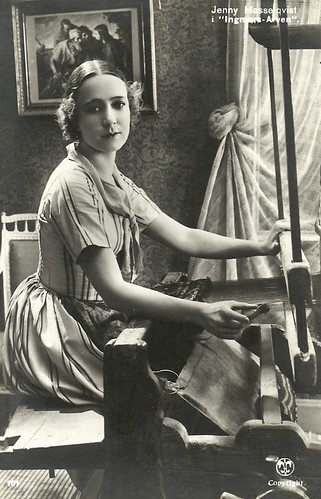
Danish postcard by Alex. Vincent's Kunstforlag, Copenhagen, no. 101. Jenny Hasselqvist in Ingmarsarvet (Gustav Molander, 1925), based on Selma Lagerlöf's book 'Jerusalem'.

German postcard by Kunst und Bild, Berlin-Charlottenburg, no. A 1647. Photo: Real Film / DFH / Lilo. Maria Emo in Das Mädchen von Moorhof/The Girl of the Moors (Gustav Ucicky, 1958), based on Selma Lagerlöf's novel 'Tösen från Stormyrtorpet'.
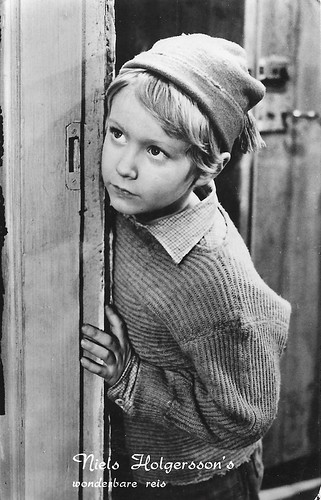
Dutch postcard by HAFBO. Sven Lundberg in Nils Holgersson underbara resa/The Adventures of Nils Holgersson/The Wonderful Adventures of Nils (Kenne Fant, 1962), released in the Netherlands as Niels Holgerssons wonderbaarlijke reis.
Sources: Wikipedia (Dutch, English and Swedish), and IMDb.
No comments:
Post a Comment